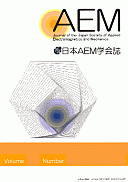Volume 31, Issue 3
Displaying 1-20 of 20 articles from this issue
- |<
- <
- 1
- >
- >|
Special Topic: Superconducting Magnetic Levitation
-
2023Volume 31Issue 3 Pages 365-371
Published: 2023
Released on J-STAGE: November 02, 2023
Download PDF (4622K) -
2023Volume 31Issue 3 Pages 372-377
Published: 2023
Released on J-STAGE: November 02, 2023
Download PDF (2900K) -
2023Volume 31Issue 3 Pages 378-381
Published: 2023
Released on J-STAGE: November 02, 2023
Download PDF (2069K) -
2023Volume 31Issue 3 Pages 382-387
Published: 2023
Released on J-STAGE: November 02, 2023
Download PDF (3552K) -
2023Volume 31Issue 3 Pages 388-393
Published: 2023
Released on J-STAGE: November 02, 2023
Download PDF (2036K) -
2023Volume 31Issue 3 Pages 394-397
Published: 2023
Released on J-STAGE: November 02, 2023
Download PDF (1530K) -
2023Volume 31Issue 3 Pages 398-405
Published: 2023
Released on J-STAGE: November 02, 2023
Download PDF (2696K)
Special Topic:The 31th MAGDA Conference in KAGOSHIMA(MAGDA2022)[Academic Papers]
-
2023Volume 31Issue 3 Pages 406-412
Published: 2023
Released on J-STAGE: November 02, 2023
Download PDF (2060K) -
2023Volume 31Issue 3 Pages 413-418
Published: 2023
Released on J-STAGE: November 02, 2023
Download PDF (2803K) -
2023Volume 31Issue 3 Pages 419-424
Published: 2023
Released on J-STAGE: November 02, 2023
Download PDF (1641K) -
2023Volume 31Issue 3 Pages 425-430
Published: 2023
Released on J-STAGE: November 02, 2023
Download PDF (2176K) -
2023Volume 31Issue 3 Pages 431-436
Published: 2023
Released on J-STAGE: November 02, 2023
Download PDF (2915K) -
2023Volume 31Issue 3 Pages 437-442
Published: 2023
Released on J-STAGE: November 02, 2023
Download PDF (2242K) -
2023Volume 31Issue 3 Pages 443-449
Published: 2023
Released on J-STAGE: November 02, 2023
Download PDF (3640K) -
2023Volume 31Issue 3 Pages 450-457
Published: 2023
Released on J-STAGE: November 02, 2023
Download PDF (2638K) -
2023Volume 31Issue 3 Pages 458-463
Published: 2023
Released on J-STAGE: November 02, 2023
Download PDF (2826K) -
2023Volume 31Issue 3 Pages 464-472
Published: 2023
Released on J-STAGE: November 02, 2023
Download PDF (4611K)
Series: Resolver, angle sensor (4)
-
2023Volume 31Issue 3 Pages 473-476
Published: 2023
Released on J-STAGE: November 02, 2023
Download PDF (1772K)
Regular Paper[Academic Papers]
-
2023Volume 31Issue 3 Pages 477-483
Published: 2023
Released on J-STAGE: November 02, 2023
Download PDF (3420K) -
2023Volume 31Issue 3 Pages 484
Published: 2023
Released on J-STAGE: November 02, 2023
Download PDF (760K)
- |<
- <
- 1
- >
- >|
